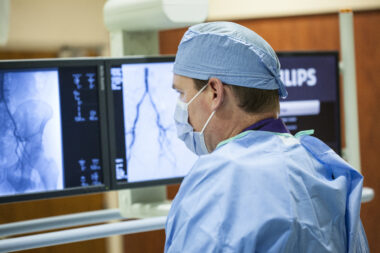Uterine fibroids are benign tumors that grow in the muscular wall of the uterus. In many cases, fibroids don’t cause any problems, making treatment unnecessary. But for some women, fibroids can cause discomfort, heavy blood loss, and lead to other complications. Here are ten uterine fibroid facts you should know.
1. Uterine Fibroids Are Common
If you have been diagnosed with uterine fibroids, you’re not alone. In fact, up to 80% of women develop fibroids by age 50.
2. Uterine Fibroids Are Not Cancerous
Fibroids are a type of benign tumor, which means they are not cancerous. Additionally, having fibroids doesn’t increase the risk of developing uterine cancer.
3. Experts Don’t Know What Causes Them
While we don’t know the reason fibroids form in the uterine wall, certain factors can raise the risk of developing fibroids. Risk factors for fibroids include:
- Your age. Fibroids are the most common for women in their 30s and 40s. After menopause, fibroids generally shrink.
- Your diet. Studies have shown that eating high amounts of red meat or ham can increase your risk for fibroids, while a diet rich in green vegetables might reduce your risk.
- Your family history. Your risk goes up if you have a family member who has had fibroids. If your mother had fibroids, your risk is about three times higher than average.
- Your race. African American women are at higher risk of developing fibroids than white women.
- Your weight. Being overweight or obese makes you more likely to have fibroids.
4. Hormones Play a Big Role
Although no one can say for sure why fibroids develop in the uterus, hormones, including estrogen and progesterone, play a part in their growth. During pregnancy, when hormone levels are much higher, fibroids grow quickly. Anti-hormone medication can cause them to shrink, and they also stop growing after a woman enters menopause.
Read More: Period Problems? It Could Be Uterine Fibroids, Endometriosis or PCOS
5. Uterine Fibroids Can Grow in Different Ways
Fibroids are categorized based on where they grow within the uterus:
- Intramural fibroids grow within the uterine wall.
- Submucosal fibroids grow into the cavity of the uterus.
- Subserosal fibroids grow on the outer lining of the uterus.
Fibroids can grow on a stalk that reaches out from the uterine surface or into the cavity of the uterus. This is called a pedunculated fibroid.
6. Uterine Fibroids Can Cause Pain and Other Symptoms
Most women who have uterine fibroids have no signs. However, some women experience certain symptoms, which can sometimes become severe:
- Heavy menstrual bleeding
- Painful menstrual cramping
- Bleeding between periods
- Enlarged lower abdomen
- Frequent need to urinate
- Full feeling in the pelvic area
- Pain in the lower back
- Painful sex
7. Uterine Fibroids Can Affect Fertility
In some women, fibroids can lead to infertility, although this isn’t common. However, many women with infertility caused by fibroids can become pregnant after receiving treatment for the fibroids. Women of child-bearing age should discuss options with a reproductive specialist before seeking treatment.
8. Having Uterine Fibroids Can Cause Pregnancy Complications
Women who have fibroids are more likely to experience problems during pregnancy and delivery than women who don’t have them, including a six times higher likelihood of needing a cesarean section. However, most pregnant women with fibroids don’t have high-risk pregnancies.
9. Doctors Can Often Feel Fibroids During a Regular Pelvic Exam
Your doctor might feel fibroids on your uterus during a routine pelvic exam. Imaging tests might be needed to confirm the diagnosis, including:
- Ultrasound, which uses sound waves to create images of the uterus and fibroids
- MRI, which produces a picture using magnets and radio waves to image the uterus and fibroids
- Hysterosalpingogram (HSG), a special type of X-ray that involves injecting dye into the uterus/endometrial canal
10. Many Treatment Options Are Available
Your doctor will take many factors into consideration when treating fibroids, including the presence and severity of symptoms, size and location of the fibroids, desire for future pregnancy, and proximity to menopause.
Treatment options include:
- Medication: Birth control drugs can be used to manage the symptoms caused by uterine fibroids. These include low-dose birth control pills, progesterone-like injections and an intrauterine device (IUD) that releases progestin. Other medications called gonadotropin releasing hormone agonists (GnRHa) can cause fibroids to shrink.
- Surgery: Options include myomectomy (surgery to remove fibroids), hysterectomy to remove the uterus and endometrial ablation to remove or destroy the uterine lining
- Uterine fibroid embolization (UFE): This minimally invasive, non-surgical, image-guided procedure blocks blood flow to the fibroids and causes them to shrink.



